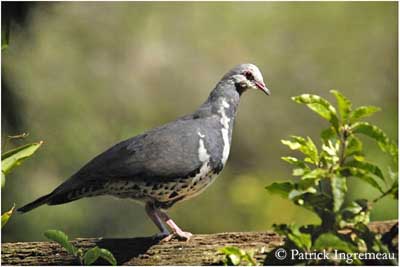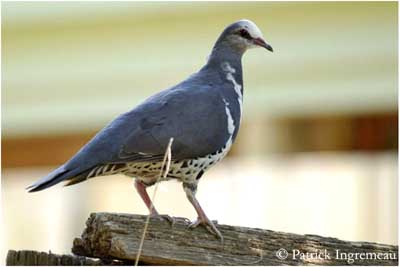
Wonga Pigeon
Leucosarcia melanoleuca
Columbiforme Order – Columbidae Family
BIOMETRICS:
Length: 36-38 cm
Weight: 330-500 g
LONGEVITE: Up to 16 years
DESCRIPTION:
Wonga Pigeon is a plump terrestrial pigeon endemic to Australia.
Adult has grey upperparts, with wings and tail slightly washed brownish.
On the underside, throat is grey, extending until the lower breast, and bordered on each side by a long white patch forming conspicuous V.
Underparts are white, spotted with blackish crescents extending to flanks. Underwings are pale brownish-grey. Undertail coverts are blackish with buffy-white edges. Tail feathers are grey, tipped white.
Head is whitish on forehead and chin. Crown and nape are grey. Bill is dark grey with pinkish-red cere. Eyes are dark brown with pinkish-red eye-ring. Lores are black. Legs and feet are pinkish-red.
Both sexes are similar.
Juvenile is browner than adults on upperparts, and has more indistinct white V on breast. Flanks are less spotted.
REPRODUCTION:
Breeding season occurs from October to January.
Nest is often placed high in large tree, up to 20 metres above the ground. This species may use old nests of other species. Nest is a bowl-shaped loose platform, made with twigs and sticks, and interior is lined with softer plant materials.
Wonga Pigeons are monogamous.
Female lays two white eggs. Incubation lasts about 18 days, shared by both parents. Young are fed by regurgitation and fledge 18 to 19 days later. They remain with adults some time after fledging, about 3 to 4 weeks, but parents feed them less and less often.
DIET:
Wonga Pigeon forages on the ground, feeding on seeds of varied plants, berries, fallen fruits and invertebrates such as insects and larvae, worms and small snails.
PROTECTION / THREATS / STATUS:
Wonga Pigeon has suffered some decline, due to land clearing, predation by feral cats and foxes, and shooting for their flesh or to protect crops. But populations have recovered secure numbers. The species is locally common in suitable habitat.
Fr: Colombine wonga
All : Wongataube
Esp : Paloma Wonga
Ital : Colombo vonga
Nd : Wongaduif
Russe : Вонга
Photographs by Patrick Ingremeau
TAMANDUA
Text by Nicole Bouglouan
Sources:
HANDBOOK OF THE BIRDS OF THE WORLD vol 4 by Josep del Hoyo-Andrew Elliott-Jordi Sargatal - Lynx Edicions - ISBN: 8487334229
PIGEONS AND DOVES by David Gibbs, Eustace Barnes and John Cox - Pica Press Sussex - ISBN: 1873403607
Birds in backyards (Birds Australia and Australian Museum)
Wikipedia (Wikipedia, The Free Encyclopedia)

VOICE: SOUNDS BY XENO-CANTO
Wonga Pigeon utters loud, far-carrying “coo-coo” often repeated several times as advertising calls. It also gives monotonous “woop-woop” calls during hours. During displays, male utters soft “coo”.
HABITAT:
Wonga Pigeon frequents temperate and subtropical rainforests. It can be seen from dense coastal rainforest up to 1,800 metres of elevation. In drier areas, it is found in wet forested gullies and riparian habitats. It can be seen in clearings, gardens close to forests, along tracks, roadsides and picnic areas.
RANGE:
Wonga Pigeon lives in Australia, mainly on east coast, from south-eastern Queensland to near Melbourne, Victoria.
BEHAVIOUR:
Wonga Pigeon feeds only on the ground, eating seeds, fallen fruits and insects. It can walk long distances, usually using the same way, well-defined routes. It occasionally takes fruit from low branches, reached from the ground.
It also feeds on invertebrates, and scratches the leaf-litter for snails, insects and worms.
Wonga Pigeon is usually seen alone or in pairs, sometimes feeding in small group, or even in larger flocks, according to the food resources in some areas.
This species is highly terrestrial, and feeds, walks and runs easily, with bobbing head. When disturbed, it runs into close undergrowth, or flies up to low branches.
During courtship displays, male courts its mate on the ground, fluffing up its plumage, displaying the bold grey and white pattern of the breast. It also raises and spreads wings and tail, and flings the head over each wing. It may repeat about ten times this movement.
Bowing displays occur occasionally, but mainly as aggressive behaviour towards rivals. Pair defends the nest-site, bowing and walking towards intruders.
Wonga Pigeons are sedentary in their range, but they can perform seasonal movements in southern parts of their range, according to food resources.
FLIGHT:
Wonga Pigeon performs loud clapping of wings when it flies up from the ground to low branch when disturbed. At this moment, it produces explosive wing claps.
